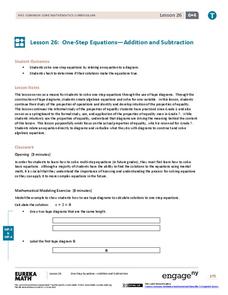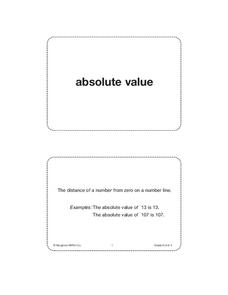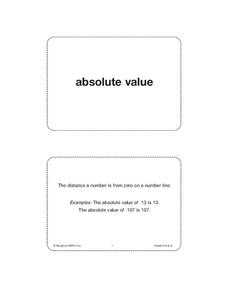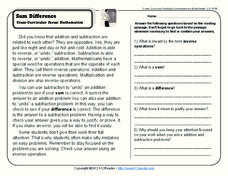Utah Education Network (UEN)
Expressions and Equations
Variables may be unknown, but expressions and equations are easy to understand. Pupils learn to write, evaluate, and simplify numeric and algebraic expressions. They also investigate how to write and solve simple equations and...
PHET
Equality Explorer
Find the right balance between concrete and abstract thinking. After using interactive balances to explore inverse operations, learners solve multi-step equations with variables on both sides. Of course, they can still use the...
Alabama Learning Exchange
Building Functions: Reverse to Inverse
Reverse the wrapping to get to the gift. Using the idea of unwrapping a gift, the instructional activity introduces the concept of inverses. Pupils first determine the order needed to evaluate a function at a point, then use the reverse...
CK-12 Foundation
Mental Math for Addition and Subtraction Equations: Marble Bag Collector
Don't lose your marbles as your learn about addition and subtraction equations. Pupils investigate the relationship between addition and subtraction by using an interactive. They drag different color marbles into a box and identify...
CK-12 Foundation
Two-Step Equations with Subtraction and Multiplication: Cupcake Equation
Solving equations is a piece of cake. Young mathematicians use an interactive to create a bar model to representing a situation involving cupcakes. They use the model to solve for the cost of a cupcake.
Virginia Department of Education
Balanced
Bring balance to your lesson plans with an activity that asks individuals to solve one-step linear equations with inverse operations. Balance scales help learners understand the concept of isolating the variable.
EngageNY
One-Step Equations—Multiplication and Division
Discover one more step to being able to solve any one-step equation. Scholars continue their work with one-step equations in the 28th installment of a 36-part module. Tape diagrams and algebraic processes introduce how to solve one-step...
EngageNY
One-Step Equations—Addition and Subtraction
Just one step is all you need to find success in solving equations. The 27th installment in a series of 36 teaches how to solve one-step equations involving addition and subtraction. Tape diagrams help future mathematicians in this task.
Noyce Foundation
Perfect Pair
What makes number pairs perfect? The resource provides five problems regarding perfect pairs of numbers, the definition of which changes in complexity with each task. Solutions require pupils to apply number sense and operations, as well...
Charleston School District
Review Unit 5: Equations
It's time for them to show you what they've learned! The review provides a sampling of the different concepts learned throughout the eight-part series. Learners solve equations by combining like terms, applying the distributive property,...
Charleston School District
Solving Equations with Variables on Both Sides
Where did all these variables come from, anyway? The previous lessons in the series ask learners to solve multi-step equations using the distributive property, combining like terms, and using inverse operations. Now scholars solve...
Charleston School District
Solving Equations by Combining Like Terms
How do you make these x's get along? Building on the previous lesson in the series, learners solve equations by combining like terms. The video uses objects to help pupils understand the concept.
Charleston School District
Solving with Inverse Operations
What does order of operations have to do with solving equations? A video explains solving two-step equations using a do/undo chart. Learners recognize the operations within an equation and use inverse operations to undo those...
Charleston School District
Solving Equations with Infinite or No Solutions
Where did all the variables go? Scholars learn how to interpret an equation when they eliminate all variables during the solving process. They interpret the solution as infinite solutions or no solutions.
Charleston School District
Solving Equations with the Distributive Property
Now there are parentheses in these equations? As the lessons continue in this series, equations get progressively more complex. Eighth graders solve equations by applying the distributive property before using inverse operations.
Houghton Mifflin Harcourt
Unit 4 Math Vocabulary Cards (Grade 6)
Reinforce math vocabulary with a set of flash cards. Forty-eight cards offer boldly printed words, and their corresponding definition alongside an example with labels. Terms include absolute value, inverse operations, slope, and more!
Houghton Mifflin Harcourt
Unit 8 Math Vocabulary Cards (Grade 5)
Reinforce math vocabulary with a set of flash cards. With a total of forty-eight cards, each are printed in bold font, and include definition cards that offer a labeled example. Terms include absolute value, ordered...
Illustrative Mathematics
Accuracy of Carbon 14 Dating II
The scientific issue of carbon-14 dating and exponential decay gets a statistics-based treatment in this problem. The class starts with a basic investigation of carbon content, but then branches out to questions of accuracy and...
K12 Reader
Sum Difference
If you need a way to address math and reading in one lesson, look no further than a passage about inverse operations, complete with reading comprehension questions. Kids focus on context clues to determine the meanings of unfamiliar words.
West Contra Costa Unified School District
Modeling Division of Fractions
Introduce young mathematicians to the process of dividing fractions with a hands-on math lesson. Using the help of fraction strips and other visual models, children work through a series of example problems as they...
Scholastic
Study Jams! Addition & Subtraction Equations
Zoe is decorating a cake for her grandpa's birthday and needs to know how many more candles to add. Follow along as she explains how to set up and solve algebraic equations in this step-by-step presentation. Equations with negative...
Scholastic
Study Jams! Relate Addition & Subtraction
Understanding the inverse relationship between addition and subtraction is essential for developing fluency in young mathematicians. Zoe and RJ explain how three numbers can form fact families that make two addition and two subtraction...
Scholastic
Study Jams! Relate Multiplication & Division
Sometimes the easiest way to understand division is to look at it as multiplication. Show your mathematicians that every problem can be written backward to make it easier for them. The video explains how the relationship between...
Curated OER
Unit 11 Year 5
Apparently unit 11 covers a range of topics related to problem solving, addition, and subtraction. This complete unit presentation is intended for use over a series of days or weeks. It contains numerous visual aids to accompany lessons...























